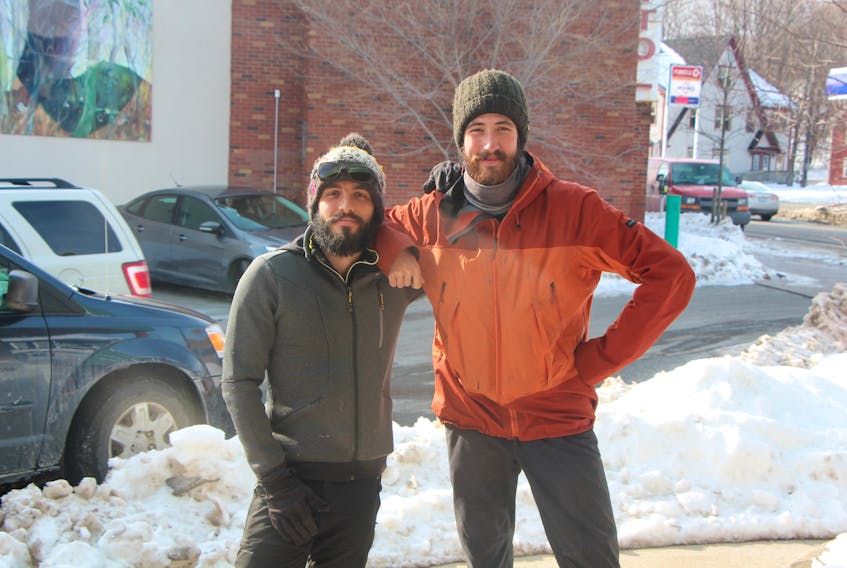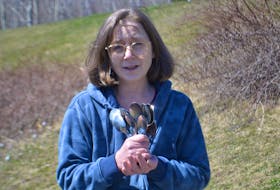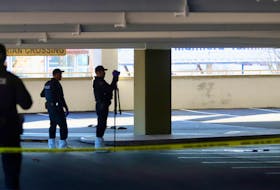ANTIGONISH, N.S. — Maxime Berthouqueau, Rémi Cayot and their dog Mata are eager to meet people in Canada, and in the case of two of the three, having a conversation as well.
The duo, who refer to themselves as the Bearded Travelers, are a pair of friends from France who were fascinated by the immensity and pristine nature of the Canadian wilderness.
Speaking to them downtown at the People’s Place library, it becomes evident very quickly why they are eager to chat – they just spent the last several months trekking on foot through the wilds of Newfoundland and rural Cape Breton.
Berthouqueau and Cayot have not subjected themselves to the whims of winter in two places it hits hardest for insignificant reasons. They are on a cross-country tour, and intend to visit the north, east and south corners of the country using the Trans-Canada Trail.
“We’re doing it just for the pleasure of discovering the country,” Cayot said. “When you’re in Europe, you hear about Canada, it’s always talked about like it’s this big place with wilderness and trees – and it’s always beautiful.”
Like many who visit Canada, Berthouqueau and Cayot were both struck by the friendliness of Canadians they met in their travels.
“We’re meeting many people, and people are friendly all the time,” Berthouqueau said, commending the amiability of the people they encountered in their travels, whether in a community or in the wilderness.
Why winter?
When asked why they chose to start their journey in the winter, Cayot said they want to experience all of the Canadian seasons on their journey – they decided to see winter first.
That made for a very interesting first leg of their journey. The freezing windy conditions and sparse population of central Newfoundland from Mile Zero in St. John’s to Port Aux Basques was their first exposure to Canada.
During the two-month trek through snow, ice, fog – and a great deal of wind – that was walking the trails in Newfoundland, Cayot and Berthouqueau once went an entire week, only seeing one person.
Despite not seeing many people, Berthouqueau and Cayot praised the hospitality of the Newfoundlanders they met along the way.
“Everyone was helping us out with our journey. Every time we needed something we’d find people helping us,” Cayot said. “The people we met would stop and ask us, ‘what are you doing outside in the winter? Come to my cabin and have some tea.’ They were always nice to us.”
One of the things they remember most distinctly about much of the trail system running through Newfoundland was how flat and straight it was.
Nova Scotia
When they landed in Nova Scotia, the Atlantic province hospitality did not end. Shortly after they disembarked from their ferry ride, Berthouqueau and Cayot offered a drive from North Sydney to Whycocomagh, to avoid having to walk on the highway, since the area between North Sydney and Whycocomagh goes along the highway.
“It’s a bit dangerous to walk with a dog on the highway,” Cayot quipped.
From Whycocomagh, the pair made their way south to Port Hawkesbury down a snowmobile trail and the coastal trail.
The going can be slow for the pair. Each carry a substantial amount of gear, including tents, sleeping bags, sleeping mats, a small camping stove – and food.
Both Berthouqueau and Cayot praised the small communities of which there is an abundance in Nova Scotia.
Since coming to Nova Scotia, they have been making better time afoot.
In Newfoundland, the pair was averaging about 15 KM a day, carrying backpacks that were inundated enough food for the long journeys afoot with nowhere to restock.
“We carry our food, so when we see no people for a week, that means we have to carry a week worth of food,” Berthouqueau said. “When there are walks of two or three days between seeing towns, it’s easier for us.”
Naturally, carrying less food helped the pair to make far better time, getting across the smaller Cape Breton in far less time.
“Now, our backpacks are lighter, and we walk faster, for longer, since the days are getting longer,” Berthouqueau said.
That being said, the amount of ground they cover in a day can vary.
“Some days we just make 5 KM and stop, and some days we do 30 KM – it depends on the weather and everything,” Berthouqueau said.
Stopping in Antigonish
Upon arriving in Antigonish, Berthouqueau and Cayot were charmed by Antigonish and its small-town feeling.
“The buildings on Main Street are beautiful,” Berthouqueau said. “Everyone is telling us its more beautiful in the summer.”
“Maybe we should come back in the summer to see the difference,” Cayot quipped.
After reaching Antigonish, Berthouqueau and Cayot originally planned to take the trail directly to New Glasgow, but concerned for Mata’s safety, decided to find a ride down Highway 104 to Pictou, where they resumed their journey on foot at the Jitney Trail in Pictou.
“We’re going to go from Pictou, along the Sunrise Trail to Wentworth,” Berthouqueau said.
From Wentworth, the pair plan on proceeding to Amherst, and eventually New Brunswick.
Next steps
As far as a schedule is concerned, Berthouqueau admitted they are unstructured, and taking their progress day-by-day.
“We planned this trip thinking it was going to take us two years,” Cayot said. “We gave ourselves time to reach the Arctic Ocean.”
Berthouqueau said they plan to go from New Brunswick to Quebec, and then intend to walk along the border Ontario shares with the U.S. to Winnipeg – and eventually Edmonton.
“If we arrive in Edmonton in the autumn, we might find a job there,” Cayot said. “If it’s summertime, we’re going to get a kayak and use the Athabasca and McKenzie Rivers to reach the Arctic Ocean, from Tuktoyaktuk.”
One thing of which they are both certain is that they don’t want to spend another winter outdoors, once they’re out west or up north.
“I think one winter in tents is enough,” Berthouqueau said.
How do they do it?
Speaking to the Casket on Mar. 7, Cayot and Berthouqueau said it was a welcome change of pace to be downtown in a “big town” like Antigonish.
Their accommodations on the go are minimalistic. Carrying their camping equipment on their backs, they usually just pitch their tents in the woods off the trail.
“We carry everything in our backpacks. We have tents and sleeping bags that are good for outside – we can sleep in temperatures down to -45 degrees (Celsius), and little mattresses we put on the ground,” Berthouqueau explained.
The pair noted they walk most of the day, eventually finding a place to set up their tents when the sun starts sinking toward the horizon.
“We usually put our tents up in the woods to protect from the wind and snow,” Cayot said. “If there’s going to be snow or rain, we put a tarp on our tent.”
When in their tents, Cayot noted they eat, sleep and spend their time in their sleeping bags to stay warm.
The hardest part of roughing it for Cayot and Berthouqueau is getting up in the morning.
“It gets a bit cold. We have to get up and out of the tent, and it’s cold,” Berthouqueau said. “We have to do everything quickly, so we can get warm by walking.”
Then, when they depart for the day, Berthouqueau and Cayot pack much of their gear into their sleeping bags to keep it warm.
“If you’re carrying water and you don’t, it will freeze the bottle of water,” Berthouqueau said.
To cook, Berthouqueau and Cayot use a small gas stove, cooking a lot of pasta, cereal and other carbohydrate-heavy foods.
“We need a lot of fiber and protein. Sometimes we boil eggs, and cook bacon and fish,” Berthouqueau said. “We need food that is very light, but useful for the body.”
Berthouqueau and Cayot noted they only eat two meals a day, so when they do eat, they make it count.
“We have breakfast, no lunch, so we eat some cereal bars during the day, but we don’t stop for lunch,” Berthouqueau explained. “We stop at the end of the day to eat supper.”









